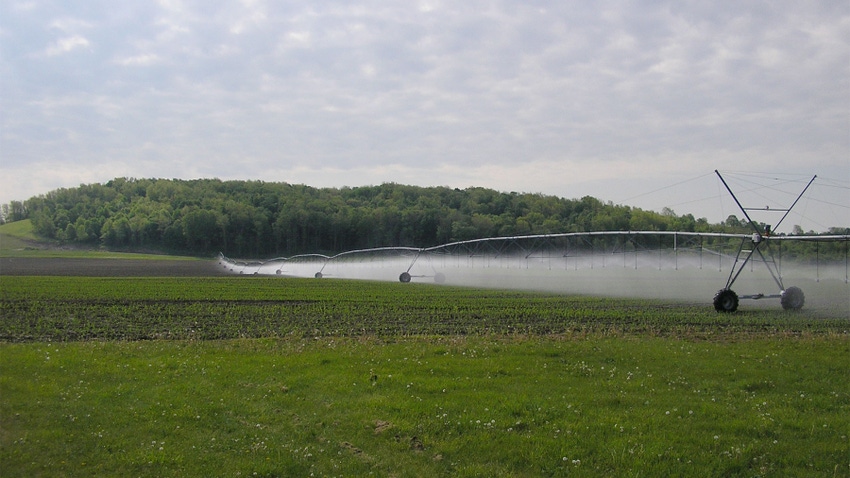January 18, 2024

Vegetable and fruit producers are accustomed to irrigating in New York, but irrigating corn is less common.
Tom and Jack Jeffres of R.L. Jeffres and Sons in Wyoming, N.Y., use irrigation as one of their strategies to ensure good yields. Their family has been irrigating, Tom said, since the 1950s when a few years of drought prompted his grandfather to buy a sprinkler system. Tom remembers helping his grandfather operate the sprinkler.
“I learned to despise irrigation as a kid,” he said during a presentation at the recent Corn Congress put on by Cornell Extension’s Northwest New York Dairy, Livestock and Field Crops Program.
The equipment was improved in the 1980s and again in the 2000s, with the purchase of a center-pivot irrigation system. With no more hose-dragging labor, the pivot irrigation system has far outstripped its predecessors.
One of the hassles of the hose-based system, Tom said, was getting the system set up, which often caused long delays in irrigating. The pivot irrigation system is all set up and ready to use whenever needed.
Why irrigate?
The Jeffreses operate 12 pivots and own 10 of them (two are on leased land). They have center pivots and hard hose travelers, and they irrigate nearly any crop that is part of their crop rotation plan. They farm about 11,000 acres, 5,000 of which are corn.
The initial investment in a pivot irrigation system is expensive, Tom said, and this can be a challenge for many producers.

FATHER AND SON: Jack and Tom Jeffres of R.L. Jeffres and Sons in Wyoming, N.Y., use irrigation as one of their strategies to ensure good corn yields. Their family has been irrigating, Tom says, since the 1950s when a few years of drought prompted his grandfather to buy a sprinkler system.
“It has paid for itself many times. We have dry ground. You can’t overwater it. If you have soil with greater water-holding capacity, it may not pay,” he said, adding that the farm’s sandy soil self-regulates irrigation water.
“We lacked a lot of late-summer rain in July and August,” he added, and irrigation has made the difference between a poor yield and a good yield.
Tom said the cost of irrigating 1 inch of water on a field is tough to estimate, as the size of the pump, the source of its power and other infrastructure needed will vary from farm to farm. Pump longevity can range from 20 to 40 years. He estimates, though, that it costs about $40 an acre to apply.
“Everything outside of the pivot didn’t grow” last season, Tom said. “We did 1 inch of water each week when we didn’t have rain and 2 inches in one area. We had tremendous yield in the low spots where the water ran together.”
Plenty of water needed
The abundant water supply on his farm’s land comes from an underground aquifer that feeds a hand-dug well, plus streams and other sources that make it easier for Tom and Jack to keep the irrigation system running. Adequate water may challenge other farms.
Although water supply is usually the top concern for producers considering an irrigation system, Jack said, “There’s infrastructure, dealing with the county,” and zoning issues and permits related to digging on the land to install the pipeline.
“Size the initial pipe to handle the pivot size and the right-sized pump,” Jack added.
It can be costly and challenging to try to upscale this infrastructure later, as a farm’s water demand will grow with the farm.
“With a reel [irrigation system], you can move it multiple places,” Jack said. “Cost isn’t a drastic difference, hose versus pivot. But you save on labor and efficiency.”
He said the cost is $60,000 for just the pivot irrigation system.
Maintain yields
If you are considering an irrigation system for your operation, Tom said to not only think about increasing yields, but also to maintain them. “If we have a wet year, we do very well on the gravel areas,” he said. “We’ve only not irrigated two years since the ‘50s. If you can get more bushels off the best fields, it gives you an advantage.”
The Jeffreses use all diesel pumps. The pivot irrigation system uses 15 pounds of pressure at the pump, which Tom said is much more economical than reels.
“One of the biggest drawbacks for reels is the wind throws off the spray pattern,” he said.
Jack added that the pivot system provides more uniformity than the reel system.
An audience Q&A generated a few more questions, including how the Jeffreses prevent fish and other things from entering the irrigation lines when using a natural water source such as a stream.
“Pulling from a river and creek, there are challenges with debris,” Jack said. “Use a Riverscreen. We’ve had zero problems since we got it. We tried cages. Nothing worked as well as Riverscreen.”
On irrigating corn, Tom said, “It’s very beneficial. We tried it with wheat, but it knocked it down. We haven’t done it since, as we don’t know how or when to do it.”
On water testing, the Jeffreses said they use natural sources and do not see the need to test the water, as it is the same water used for irrigation since the 1950s and has supplied the farmhouse since the 1850s.
Tom recommended checking the website Dig Safely New York or a similar website to ensure that any installation project on your farm does not cause problems.
Sergeant writes from central New York.
Read more about:
IrrigationAbout the Author(s)
You May Also Like




